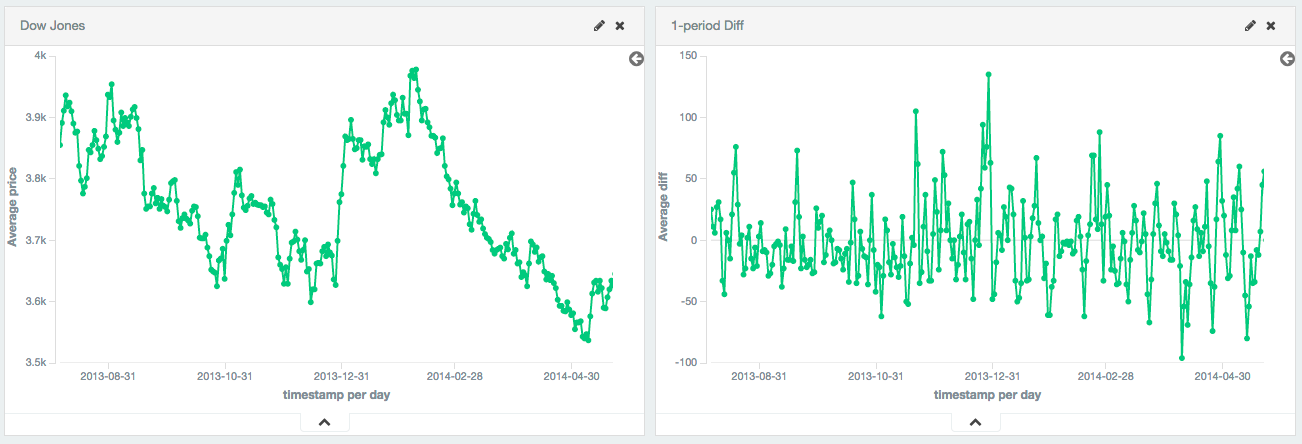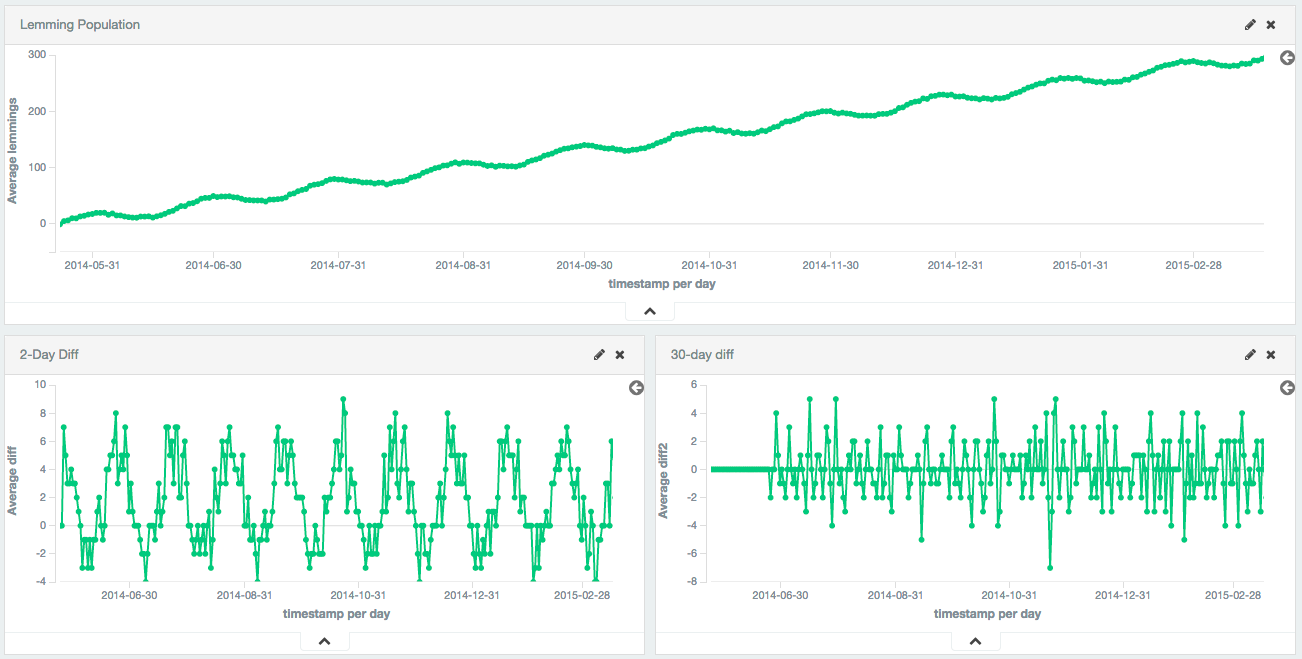# Serial Differencing Aggregation(串行差異聚合)
串行差分是將在一個時間序列中的值減去其本身滯后一段時間或周期的值。例如,數據點 f(x) = f(xt) - f(xt-n),其中n是所使用的周期。
周期1相當于沒有時間歸一化的導數:它表是從一個點到下一個點的變化。單個周期對于消除不變的線性趨勢很有用。
單個周期也可用于將數據轉換為固定的序列。在這個例子中,道瓊斯指數繪制了超過250天左右。原始數據不是靜止的,這會使得很難使用這些數據。
通過計算第一個差值,我們去除趨勢數據(例如刪除常數,線性趨勢)。我們可以看到數據成為一個固定的序列(例如,第一個差異是隨機分布在零值附近,似乎沒有任何模式/行為)。這個轉換揭示了數據集是隨機游走的;該值是先前的值加減隨機隨機。這種洞察允許選擇進一步的分析工具。
圖15\. 道瓊斯數據繪畫和通過第一個差值來穩定數據。

可以使用更大的時間段來消除季節性/循環性。在這個例子中,以正弦波+恒定線性趨勢+隨機噪聲綜合生成了一個引理群。正弦波有30天的時間。
第一個差異消除了恒定的趨勢,只剩下一個正弦波。然后將第30個差值應用于第一個差異以消除循環行為,留下適合于其他分析的固定序列。
圖16.繪制了第一和第30個差異的靜止數據

# Syntax(句法)
**serial_diff**?聚合看起來像這樣:
|
`{`
`"serial_diff"``: {`
`"buckets_path"``:?``"the_sum"``,`
`"lag"``:?``"7"`
`}`
`}`
|
Table 13\. serial_diff 參數
|
參數名稱
|
描述
|
是否必填
|
默認值
|
| --- | --- | --- | --- |
| buckets_path | 感興趣的度量的路徑(更多細節可以看[buckets_path](https://www.elastic.co/guide/en/elasticsearch/reference/5.4/search-aggregations-pipeline.html#buckets-path-syntax)?語法) | 必填 | ? |
| lag | 從當前的值減去歷史?**bucket**。比如,lag=7表示每次從當前的?**bucket?**的值減去其前面第7個?**bucket?**的值。必須是非零正整數。 | 可選 | 1 |
| gap_policy | 確定遇到數據間隙時的策略 | 可選 | insert_zero |
| format | 格式化聚合輸出的值 | 可選 | null |
**serial_diff**?聚合必須嵌入到?**histogram**?或者?**date_histogram**?聚合中:
|
`curl -XPOST?``'localhost:9200/_search?pretty'`?`-H?``'Content-Type: application/json'`?`-d'`
`{`
`"size"``:?``0``,`
`"aggs"``: {`
`"my_date_histo"``: {?????????????``1`????
`"date_histogram"``: {`
`"field"``:?``"timestamp"``,`
`"interval"``:?``"day"`
`},`
`"aggs"``: {`
`"the_sum"``: {`
`"sum"``: {`
`"field"``:?``"lemmings"`?????`2`
`}`
`},`
`"thirtieth_difference"``: {`
`"serial_diff"``: {???????????????``3`
`"buckets_path"``:?``"the_sum"``,`
`"lag"`?`:?``30`
`}`
`}`
`}`
`}`
`}`
`}`
`'`
|
| 1 | ?一個命名為“**date_histogram**” 的?**date_histogram**?, 由 timestamp 字段和 一天間隔組成。 |
| 2 | **sum**?度量是用來計算字段的和。可以填很多值(sum, min, max, etc) |
| 3 | 最后,我們指定一個以?**the_sum**?作為輸入的?**serial_diff?**聚合。 |
串行差分通過在字段上指定?**histogram?**或者?**date_histogram**。你可以選擇選擇性的添加常規的度量,例如sum。最后 ?**serial_diff?**被嵌入到?**histogram中**。然后?**buckets_path?**參數用于指向histogram中的一個同級的度量。(有關buckets_path的語法,請參見[buckets_path](https://www.elastic.co/guide/en/elasticsearch/reference/5.4/search-aggregations-pipeline.html#buckets-path-syntax)?這節)。
- 入門
- 基本概念
- 安裝
- 探索你的集群
- 集群健康
- 列出所有索引庫
- 創建一個索引庫
- 索引文檔創建與查詢
- 刪除一個索引庫
- 修改你的數據
- 更新文檔
- 刪除文檔
- 批量處理
- 探索你的數據
- 搜索API
- 查詢語言介紹
- 執行搜索
- 執行過濾
- 執行聚合
- 總結
- Elasticsearch設置
- 安裝Elasticsearch
- .zip或.tar.gz文件的安裝方式
- Install Elasticsearch with .zip on Windows
- Debian軟件包安裝方式
- RPM安裝方式
- Install Elasticsearch with Windows MSI Installer
- Docker安裝方式
- 配置Elasticsearch
- 安全配置
- 日志配置
- 重要的Elasticsearch配置
- 重要的系統配置
- 系統設置
- 在jvm.options中設置JVM堆大小
- 禁用swapping
- 文件描述符
- 虛擬內存
- 線程數
- DNS cache settings
- 啟動前檢查
- 堆大小檢查
- 文件描述符檢查
- 內存鎖定檢查
- 最大線程數檢查
- 最大虛擬內存檢查
- Max file size check
- 最大map數檢查
- JVM Client模式檢查
- 串行收集使用檢查
- 系統調用過濾檢查
- OnError與OnOutOfMemoryError檢查
- Early-access check
- G1GC檢查
- Elasticsearch停機
- Elasticsearch升級
- 滾動升級
- 全集群重啟升級
- 索引重建升級
- Set up X-Pack
- Installing X-Pack
- X-Pack Settings
- Watcher Settings
- Configuring Security
- Breaking changes in 6.0
- X-Pack Breaking Changes
- 重大變化
- 6.0的重大變化
- 聚合變化
- Cat API變化
- 客戶端變化
- 集群變化
- 文檔API變化
- 索引變化
- 預處理變化
- 映射變化
- Packaging變化
- Percolator變化
- 插件變化
- 索引重建變化
- 信息統計變化
- DSL查詢變化
- 設置變化
- 腳本變化
- API約定
- 多索引語法
- 索引庫名稱的日期運算
- 常用選項
- URL-based訪問控制
- 文檔APIs
- 讀寫文檔
- 索引接口
- Get接口
- Delete API
- Delete By Query API
- Update API
- Update By Query API
- Multi Get API
- Bulk API
- Reindex API
- Term Vectors
- Multi termvectors API
- ?refresh
- 搜索APIs
- Search
- URI Search
- Request Body Search
- Query
- From / Size
- Sort
- Source filtering
- Fields
- Script Fields
- Doc value Fields
- Post filter
- Highlighting
- Rescoring
- Search Type
- Scroll
- Preference
- Explain
- Version
- Index Boost
- min_score
- Named Queries
- Inner hits
- Field Collapsing
- Search After
- Search Template
- Multi Search Template
- Search Shards API
- Suggesters
- Term suggester
- Phrase Suggester
- Completion Suggester
- Context Suggester
- Returning the type of the suggester
- Multi Search API
- Count API
- Validate API
- Explain API
- Profile API
- Profiling Queries
- Profiling Aggregations
- Profiling Considerations
- Field Capabilities API
- Aggregations
- Metrics Aggregations
- 平均值聚合
- 值計數聚合(Value Count Aggregation)
- Cardinality Aggregation
- Extended Stats Aggregation
- 地理邊界聚合
- 地理重心聚合
- Max Aggregation
- Min Aggregation
- Percentiles Aggregation
- Percentile Ranks Aggregation
- Scripted Metric Aggregation
- Stats Aggregation
- Sum Aggregation
- Top hits Aggregation
- Value Count Aggregation
- Bucket Aggregations
- 鄰接矩陣聚合
- Children Aggregation
- Date Histogram Aggregation
- Date Range Aggregation
- Significant Terms Aggregation
- Filter Aggregation(過濾器聚合)
- Filters Aggregation
- Geo Distance Aggregation(地理距離聚合) 轉至元數據結尾
- GeoHash grid Aggregation(GeoHash網格聚合)
- Global Aggregation(全局聚合) 轉至元數據結尾
- Histogram Aggregation
- IP Range Aggregation(IP范圍聚合)
- Missing Aggregation
- Nested Aggregation(嵌套聚合)
- Range Aggregation(范圍聚合)
- Reverse nested Aggregation
- Sampler Aggregation
- Significant Terms Aggregation
- Significant Text Aggregation
- Terms Aggregation
- Pipeline Aggregations
- Avg Bucket Aggregation
- Derivative Aggregation(導數聚合)
- Max Bucket Aggregation
- Min Bucket Aggregation
- Sum Bucket Aggregation
- Stats Bucket Aggregation
- Extended Stats Bucket Aggregation(擴展信息桶聚合)
- Percentiles Bucket Aggregation(百分數桶聚合)
- Moving Average Aggregation
- Cumulative Sum Aggregation(累積匯總聚合)
- Bucket Script Aggregation(桶腳本聚合)
- Bucket Selector Aggregation(桶選擇器聚合)
- Serial Differencing Aggregation(串行差異聚合)
- Matrix Aggregations
- Matrix Stats
- Caching heavy aggregations
- Returning only aggregation results
- Aggregation Metadata
- Returning the type of the aggregation
- Indices APIs
- Create Index /創建索引
- Delete Index /刪除索引
- Get Index /獲取索引
- Indices Exists /索引存在
- Open / Close Index API /啟動關閉索引
- Shrink Index /縮小索引
- Rollover Index/滾動索引
- Put Mapping /提交映射
- Get Mapping /獲取映射
- Get Field Mapping /獲取字段映射
- Types Exists
- Index Aliases
- Update Indices Settings
- Get Settings
- Analyze
- Explain Analyze
- Index Templates
- 索引統計信息
- 索引段
- 索引恢復
- 索引分片存儲
- 清理緩存
- 刷新
- 同步刷新
- 重新加載
- 強制合并
- Cat APIs
- cat aliases
- cat allocation
- cat count
- cat fielddata
- cat health
- cat indices
- cat master
- cat nodeattrs
- cat nodes
- cat pending tasks
- cat plugins
- cat recovery
- cat repositories
- cat segments
- cat shards
- cat thread pool
- cat snapshots
- cat templates
- Cluster APIs
- 集群健康
- 集群狀態
- 集群統計
- 掛起的集群任務
- 集群重新路由
- Cluster Update Settings
- Nodes Stats
- Nodes Info
- Nodes Feature Usage
- Remote Cluster Info
- Task Management API
- Nodes hot_threads
- Cluster Allocation Explain API
- Query DSL
- 查詢context與過濾context
- Match All Query
- 全文搜索
- 匹配查詢
- 短語匹配查詢
- 短語前綴匹配查詢
- 多字段查詢
- 常用術語查詢
- 查詢語句查詢
- 簡單查詢語句
- Term level queries
- Term Query
- Terms Query
- Range Query
- Exists Query
- Prefix Query
- Wildcard Query
- Regexp Query
- Fuzzy Query
- Type Query
- Ids Query
- 復合查詢
- Constant Score 查詢
- Bool 查詢
- Dis Max 查詢
- Function Score 查詢
- Boosting 查詢
- Joining queries
- Has Child Query
- Has Parent Query
- Nested Query(嵌套查詢)
- Parent Id Query
- Geo queries
- GeoShape Query(地理形狀查詢)
- Geo Bounding Box Query(地理邊框查詢)
- Geo Distance Query(地理距離查詢)
- Geo Polygon Query(地理多邊形查詢)
- Specialized queries
- More Like This Query
- Script Query
- Percolate Query
- Span queries
- Span Term 查詢
- Span Multi Term 查詢
- Span First 查詢
- Span Near 查詢
- Span Or 查詢
- Span Not 查詢
- Span Containing 查詢
- Span Within 查詢
- Span Field Masking 查詢 轉至元數據結尾
- Minimum Should Match
- Multi Term Query Rewrite
- Mapping
- Removal of mapping types
- Field datatypes
- Array
- Binary
- Range
- Boolean
- Date
- Geo-point datatype
- Geo-Shape datatype
- IP datatype
- Keyword datatype
- Nested datatype
- Numeric datatypes
- Object datatype
- Text
- Token數
- 滲濾型
- join datatype
- Meta-Fields
- _all field
- _field_names field
- _id field
- _index field
- _meta field
- _routing field
- _source field
- _type field
- _uid field
- Mapping parameters
- analyzer(分析器)
- normalizer(歸一化)
- boost(提升)
- Coerce(強制類型轉換)
- copy_to(合并參數)
- doc_values(文檔值)
- dynamic(動態設置)
- enabled(開啟字段)
- eager_global_ordinals
- fielddata(字段數據)
- format (日期格式)
- ignore_above(忽略超越限制的字段)
- ignore_malformed(忽略格式不對的數據)
- index (索引)
- index_options(索引設置)
- fields(字段)
- Norms (標準信息)
- null_value(空值)
- position_increment_gap(短語位置間隙)
- properties (屬性)
- search_analyzer (搜索分析器)
- similarity (匹配方法)
- store(存儲)
- Term_vectors(詞根信息)
- Dynamic Mapping
- Dynamic field mapping(動態字段映射)
- Dynamic templates(動態模板)
- default mapping(mapping中的_default_)
- Analysis
- Anatomy of an analyzer(分析器的分析)
- Testing analyzers(測試分析器)
- Analyzers(分析器)
- Configuring built-in analyzers(配置內置分析器)
- Standard Analyzer(標準分析器)
- Simple Analyzer(簡單分析器)
- 空白分析器
- Stop Analyzer
- Keyword Analyzer
- 模式分析器
- 語言分析器
- 指紋分析器
- 自定義分析器
- Normalizers
- Tokenizers(分詞器)
- Standard Tokenizer(標準分詞器)
- Letter Tokenizer
- Lowercase Tokenizer (小寫分詞器)
- Whitespace Analyzer
- UAX URL Email Tokenizer
- Classic Tokenizer
- Thai Tokenizer(泰語分詞器)
- NGram Tokenizer
- Edge NGram Tokenizer
- Keyword Analyzer
- Pattern Tokenizer
- Simple Pattern Tokenizer
- Simple Pattern Split Tokenizer
- Path Hierarchy Tokenizer(路徑層次分詞器)
- Token Filters(詞元過濾器)
- Standard Token Filter
- ASCII Folding Token Filter
- Flatten Graph Token Filter
- Length Token Filter
- Lowercase Token Filter
- Uppercase Token Filter
- NGram Token Filter
- Edge NGram Token Filter
- Porter Stem Token Filter
- Shingle Token Filter
- Stop Token Filter
- Word Delimiter Token Filter
- Word Delimiter Graph Token Filter
- Stemmer Token Filter
- Stemmer Override Token Filter
- Keyword Marker Token Filter
- Keyword Repeat Token Filter
- KStem Token Filter
- Snowball Token Filter
- Phonetic Token Filter
- Synonym Token Filter
- Synonym Graph Token Filter
- Compound Word Token Filters
- Reverse Token Filter
- Elision Token Filter
- Truncate Token Filter
- Unique Token Filter
- Pattern Capture Token Filter
- Pattern Replace Token Filter
- Trim Token Filter
- Limit Token Count Token Filter
- Hunspell Token Filter
- Common Grams Token Filter
- Normalization Token Filter
- CJK Width Token Filter
- CJK Bigram Token Filter
- Delimited Payload Token Filter
- Keep Words Token Filter
- Keep Types Token Filter
- Classic Token Filter
- Apostrophe Token Filter
- Decimal Digit Token Filter
- Fingerprint Token Filter
- Minhash Token Filter
- Character Filters(字符過濾器)
- HTML Strip Character Filter
- Mapping Character Filter
- Pattern Replace Character Filter
- 模塊
- Cluster
- 集群級路由和碎片分配
- 基于磁盤的分片分配
- 分片分配awareness
- 分片分配過濾
- Miscellaneous cluster settings
- Scripting
- Painless Scripting Language
- Lucene Expressions Language
- Advanced scripts using script engines
- Snapshot And Restore
- Thread Pool
- Index Modules(索引模塊)
- 預處理節點
- Pipeline Definition
- Ingest APIs
- Put Pipeline API
- Get Pipeline API
- Delete Pipeline API
- Simulate Pipeline API
- Accessing Data in Pipelines
- Handling Failures in Pipelines
- Processors
- Monitoring Elasticsearch
- X-Pack APIs
- X-Pack Commands
- How To
- Testing(測試)
- Glossary of terms
- Release Notes
- X-Pack Release Notes
